Introduction To The PCM vs Bitstream Discussion
In this update, we can certify that for the users, there is practically no noticeable difference in quality between PCM and Bitstream (1) (2). We will discuss below the evidence that we have to demonstrate it (3) (4). Likewise, we will also mention a few cases where the PCM vs Bitstream discussion has relevance (5) (6) and you should care about it (7) (8).
Players (we include Blu-ray players or any kind of player) have various options for audio and video output settings, depending on how the player is physically connected to the AV receiver (10).
If you have your player connected to the AV receiver via HDMI, there are 2 main audio output settings available: Bitstream and PCM (9).
In terms of the actual audio quality, whether you have the audio output configured via HDMI to PCM or Bitstream is not important (11).
In terms of the actual audio quality, whether you have the audio output configured via HDMI to PCM or Bitstream is not important.
For audio, if you connect your Blu-ray Disc player to your home theater receiver via HDMI, there are two main audio output settings available: Bitstream and PCM (similar to LPCM, but not the same thing). In terms of actual audio quality, it does not matter if the HDMI audio output from your Blu-ray Disc player is set to PCM or Bitstream.
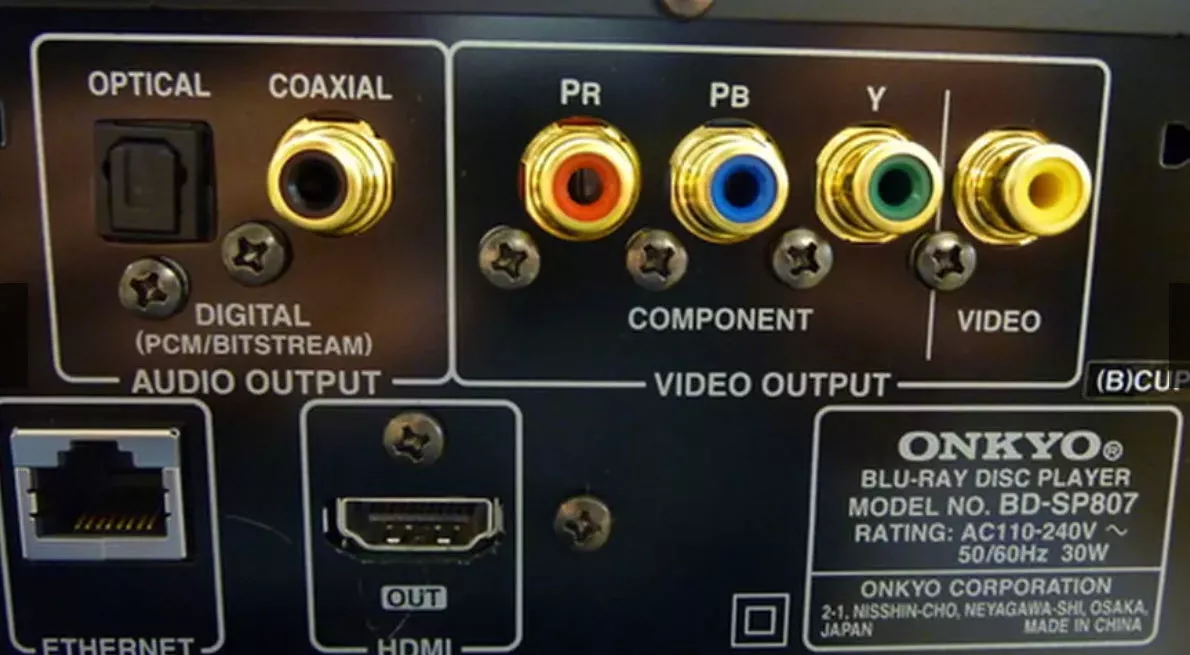
PCM gets the sound directly from your console without having to go through a home theater to get it right. For me, PCM is for those who do not use speakers or play with headphones.
Without speakers, the DTS and Dolby options will sound looser than PCM losing quality in the volume and smaller sounds.
When it comes to setting up an audio system, in the discussion of PCM vs Bitstream, people often confuse LPCM and PCM with Bitstream. Others still do not know which option to choose or which is best for them.
PCM or Bitstream: The Bottom Line
For audio, if you connect a device (Blu-ray Disc player, Ultra HD Blu-ray disc players or other similar devices) to a home theater receiver via HDMI, there are two main audio output settings available: Bitstream vs PCM (which is similar, but not equal, to LPCM).
In terms of sound quality, whether you set the device (Blu-ray Disc player or another device) HDMI audio output PCM or Bitstream does not matter, generally speaking. However, here is what happens when you choose either setting.
If you set the Blu-ray Disc player to output audio as PCM, the player performs the audio decoding of all Dolby/Dolby TrueHD and DTS/DTS-HD Master Audio-related soundtracks internally. Then, it sends the decoded audio signal in an uncompressed form to the home theater receiver.
I have checked the setting on the Pioneer Kuro, my favorite 1080p TV, and the audio output is set to Dolby Digital (PCM is the other choice). It s available also in 720p devices.
As a result, the home theater receiver will not perform additional audio decoding before the audio is sent through the amplifier section and the speakers. With this option, the home theater receiver displays the term PCM or LPCM on its front panel display.
If you plan to use the secondary audio feature, which provides access to audio commentaries, descriptive audio, and supplementary audio tracks, use PCM. When access to these audio programs is important to you, set the Blu-ray player to PCM to provide the best quality result. The player decodes the audio, without bandwidth concern, which is an issue for bitstream.
For digital optical and coaxial connections, while the bitstream output option can send a standard Dolby Digital or DTS 5.1 surround sound signal to a receiver for decoding, the PCM option sends a two-channel signal. A digital optical or digital coaxial cable does not have sufficient bandwidth capacity to transfer a decoded, uncompressed, full surround audio signal like an HDMI connection can.
If you select Bitstream as the HDMI audio output setting for a Blu-ray player, the player bypasses its internal Dolby and DTS audio decoders and sends the undecoded signal to your HDMI-connected home theater receiver. The home theater receiver does the audio decoding of the incoming signal. As a result, the receiver will display Dolby, Dolby TrueHD, DTS, DTS-HD Master Audio, Dolby Atmos, DTS:X, or another format on its front panel display depending on which type of bitstream signal is decoded.
If you combine the bitstream and secondary audio settings, the Blu-ray Disc player will down-res surround formats, such as Dolby TrueHD or DTS-HD, to standard Dolby Digital or DTS to squeeze both types of audio signals into the same bitstream bandwidth. In this case, the home theater receiver recognizes the signal as standard Dolby Digital and decodes appropriately.
PCM vs Bitstream For Soundbar
The settings here do not depend only on the soundbar you have. We need to analyze the entire landscape architecture, which encompasses the emission of the sound and the data layer.
Let´s see
Bitstream is a preferred option, and it is a must if you want Atmos out of your TV. Nevertheless, even if your TV supports Atmos, your soundbar should support it as well. On the TV side, you should set it to “Bitstream” as that setting basically “passes through whatever format is playing to the soundbar system.
PCM seems more suitable for games instead. This means that on a console, such as the PS4 or PS5, you should set it to PCM because that setting will furnish you with uncompressed audio from games.
But if instead of playing games on your PS4 or your PS5 you are playing a Blu-Ray, the settings are different because game audio and Blu-Ray audio have different configurations. With a Blu-Ray movie, start playing it (otherwise the options will be greyed and unavailable depending on the model) and choose the sound format “Bitstream” in the dropdown menu.
I have not used a PS2 or PS3 so I cannot tell you how to the settings there.
Therefore, regarding the discussion of PCM vs Bitstream for a soundbar, we can define that PCM is really for 2.1 ch systems and does not provide full surround sound.
Bitstream, on the other hand, will allow whatever sound system you have “passthrough” (depending of course, on what your soundbar is connected to) and allow it to have full surround sound.
Furthermore, Bitstream through the TV can take advantage of Auto Low Latency Mode and Variable Refresh Rate. So always consider the TV and not only the soundbar when defining if you can choose PCM vs Bitstream
So if you use PCM you would only have a left and right speaker, with disregard for your actual landscape architecture like if you had a 2.1ch soundbar, representing a mere left and right channel.
So do not use PCM if you have a soundbar of 3.1ch or more. Otherwise, you would be “downgraded”.
If you have a soundbar with 2.1ch that does not support Atmos, then you may go for the PCM option. If the device supports Dolby Atmos, then Bitstream should be selected.
This analysis is also valid if you are using an internal app such as Netflix.
PCM vs Bitstream For Atmos
Bitstream should be preferred over PCM for Dolby Atmos through the option “Bitstream” or “Auto” in modern consumer home audio systems
For Dolby Atmos to be decoded by a TV, sound bar, or AVR, the source device (Streaming device, Blu Ray player, or UHD player) must be set to send the bitstream output. When a device converts the audio to PCM, it must down mix it to channels. The only standards for PCM are 2.0, 5.1, or 7.1 channels. So if you only have a 7.1 or less system with only speakers around you, and no overheads, then PCM will probably sound the same. But anything more than 7.1 speakers around you, you will not get all of the benefits of Dolby Atmos through PCM. Some systems can activate the “Dolby Surround Upmixer” to then create overhead sounds, but these will not be the same as the content creator had intended. All of the extra data needed to produce the real-time panning and overhead sounds can only get to the decoder by sending the original bitstream
Dolby Atmos is metadata that rides on top of Dolby Digital Plus or Dolby TrueHD which provides the codes for height channels in a Dolby Atmos-compatible surround sound setup.
Dolby Digital provides sound from your existing speaker setup while Dolby Atmos uses the software as well as compatible hardware. This means that Dolby Atmos creates a superior sound experience than Dolby Digital because of the required hardware.
Just let me clarify that PCM and Dolby Atmos are two unrelated entities.
PCM is one way of digitally representing sampled analog signals. It is the decoded uncompressed form of most digital audio chains and systems, right before the DAC. Whatever processing has happened ultimately results in a PCM stream. A PCM stream can have as many discrete channels in it as required (typically from 1 to 10).
Dolby Atmos is a lossy audio codec, one of many there are. After the signal has been demuxed (so processed through a demultiplexer) after coming off the source, it is decoded, processed, uncompressed and the result is a PCM stream that has the requisite number of channels in it, ready to be fed to the DAC.
PCM vs Bitstream For Samsung TV
If you have a smart TV, notably a Samsung TV, there are some important differences in the settings for this PCM vs bitstream for the Samsung TV devices, and applicable also to new TV models.
- Setting PCM vs bitstream in the Samsung TV menu when you connect external devices through HDMI.
- Setting the output format for setting devices that receive sound from the Samsung TV, such as a soundbar, home theater system, or headphones
Let´s see these two simple options
PCM vs Bitstream In The Samsung TV When Connecting External Devices Through HDMI
When connecting an external device, there’s one more thing you need to take into consideration, and that’s the HDMI Input Audio Format. If you do not connect any HDMI input devices to your TV, you do not need to change this setting.
To set up your TV’s input audio, navigate to Settings and select Sound, and then select Expert Settings. Select HDMI Input Audio Format, and choose between the two available audio formats, PCM or bitstream as in the screenshot below.
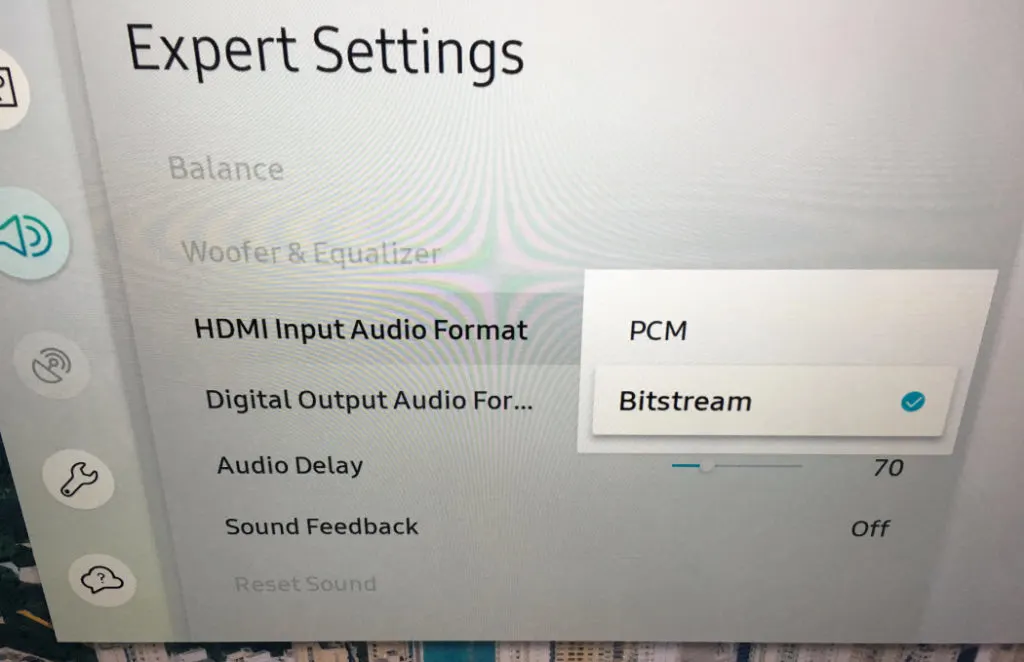
PCM: Use this setting if the external device you have connected to the HDMI port of the Samsung TV has already processed the sound, and you just want it to come out of your TV’s speakers.
This setting configuration for the Samsung TV changes the signal to 2.0 PCM as it passes through the TV. If you select PCM even though you have a home theater system or soundbar connected, the sound system will only receive 2.0 channel sound and the result will not be multi-channel surround sound, even if the sound system is capable of multi-channel PCM audio.
Bitstream: Use this setting if you plan to have audio processed by a home theater system or soundbar, after passing through the TV.
If you select Bitstream, but do not have a home theater system or soundbar connected, then the TV will process the audio in addition to outputting it. This can often result in reduced volume or other losses in audio quality. We recommend selecting PCM when using the TV’s speakers.
Even if in theory you could lose sound quality, I have not noticed any practical difference in sound quality
This setting is required in order for a home theater system or soundbar to be able to offer multi-channel surround sound from other devices connected to the TV if it is capable of it.
Digital Output Audio Setting For Samsung TV
Remember, the output format is for devices that receive sound from the TV, such as a soundbar, home theater system, or headphones.
If you are not connecting one of these to your Samsung TV, then you should leave this setting on PCM, or you may experience reduced audio volume or other issues.
In practice, I have not noticed this reduced audio volume, anyway, but the technical best practice here is to leave the setting in PCM.
For the best sound experience such as multi-channel surround sound, set this to the highest mode that your sound system can support. For modes with more than 5.1 channels of audio, an optical cable will not suffice. You will need to connect the sound system using HDMI ARC.
Navigate to Settings, and then select Sound. Select Expert Settings, and then select Digital Output Audio Format. Next, choose your desired audio format:
PCM: This setting is only recommended to use if your sound system experiences issues on higher settings (meaning the system may not be compatible with Dolby), or if it is the only option available for the content you are currently displaying on the TV. This setting will only output the left and right channels (2.0) and is not capable of multi-channel surround sound.
Dolby Digital: This provides a multi-channel audio experience, up to 5.1 channels of sound. It is compressed enough that it can be used with an optical cable. Use this setting in order to enjoy multi-channel surround sound from sound systems that are capable of 5.1 processing.
Difference Between PCM And Bitstream At A Glance
The difference between PCM and Bitstream is in regards to the device utilized for decoding the compressed format to retrieve the uncompressed PCM data. If you utilize Bitstream, then the AV receiver is performing the decode. PCM is not better than Bitstream format in terms of quality. The Bitstream package is where the PCM data was sourced from.
Aside from sound quality, there is one reason to prefer sending PCM over Bitstream—secondary audio. On most Blu-rays, there are audio elements in addition to the main soundtrack—specifically, the audio that accompanies PIP (picture-in-picture) commentaries and the sounds that onscreen buttons make when you click on them. If you set the player to send Bitstream, you will not hear this secondary audio, but if you set it to send PCM, the secondary audio is mixed with the main soundtrack so you can hear it.
PCM Pros And Cons
Pros
- Better quality access to additional audio tracks.
- Quicker, direct, and eliminates lag.
- Less work for the receiver.
- Decoding is done in the player (Blu-ray player or any player device).
Cons
- PCM transmits a two-channel signal over digital optical or coaxial.
- Audio quality is partially determined by the player (Blu-ray player or any player).
- More work is done by the player.
Bitstream Pros And Cons
Pros
- Bitstream sends an encoded 5.1 signal over digital optical or coaxial.
- Possibility of higher quality sound.
- If the receiver offers higher quality audio processing, it can be used.
- The home receiver decodes audio.
Cons
- Supplemental audio is scaled down, which decreases quality.
- It requires a high-quality receiver to achieve better results.
- More work is placed on the receiver.
The PCM Option
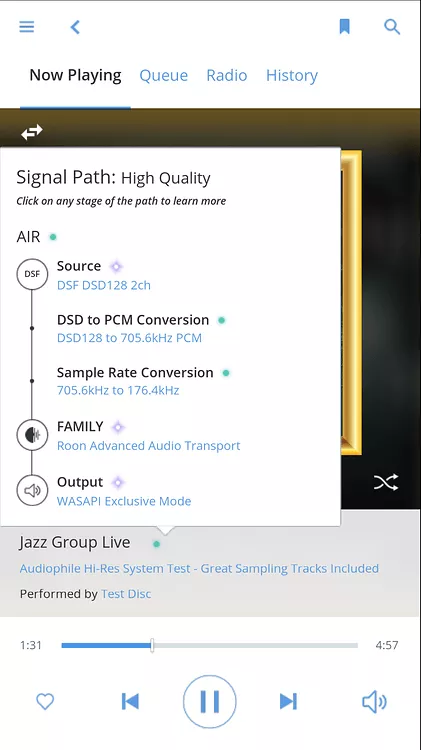
The picture above is for the settings of the Devialet Phantom Gold speakers that I have reviewed too. The setting is also applicable for the Phantom Silver, but I do not own that model.
To continue with this PCM vs Bitstream discussion, let´s see a practical setting in PCM.
If you set your Blu-ray Disc player to output audio as PCM, the player will perform audio decoding of all Dolby/Dolby TrueHD and DTS/DTS-HD Master Audio related soundtracks internally and send the decoded audio signal in the uncompressed form to the home theater receiver.
As a result, your home theater receiver will not have to do any additional audio decoding before the audio is sent through the amplifier and speaker section. With this option, your home theater receiver will display “PCM” or “LPCM” on the front panel display.
This means that if you set the audio output of your Blu-ray player to PCM, the player will decode the audio of all Dolby/Dolby TrueHD and DTS/DTS-HD Master Audio formats – from the internally related soundtracks and send the audio signal in an uncompressed form to the AV receiver in your home theater.
As a result, the AV receiver will not have to perform any additional audio decoding before it is sent to the amplifier section and speakers.
This type of connection is available on most CD players.
With this option, the home theater receiver will display the PCM term on its front panel display.
The Bitstream Option
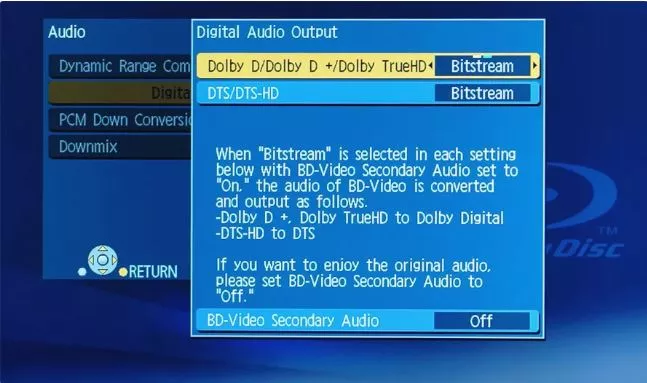
If you select Bitstream as your HDMI audio output setting from your Blu-ray player, the player will bypass its internal Dolby and DTS audio decoder and send the signal without decoding to the AV receiver connected to the HDMI.
Then, if the user decides to use Bitstream as the HDMI audio output setting for their Blu-ray player, the player will bypass its own internal Dolby and DTS audio decoders and send the signal without decoding to their HDMI-connected home theater receiver.
The home theater receiver will do all the audio decoding of the incoming signal. As a result, the receiver will display Dolby, Dolby TrueHD, DTS, DTS-HD Master Audio, Dolby Atmos, DTS:X, etc…on its front panel display, depending on the type of bitstream signal being decoded.
With this setting, the AV receiver will do all the audio decoding of the incoming signal.
As a result, in this case, the AV receiver will display on its main display the tags Dolby, Dolby TrueHD, DTS, DTS-HD Master Audio, Dolby Atmos, DTS:X, etc… depending on what type of Bitstream signal is being decoded.
It should be noted that the Dolby Atmos and DTS:X surround formats are only available from a Blu-Ray player via the Bitstream option. There is currently no Blu-ray player that can decode these formats internally for PCM and pass them on to the Home Theater receiver, which in part finishes this PCM vs Bitstream confrontation.
You have the option to choose which type of setting to use (PCM vs Bitstream), and as mentioned above, each setting should produce the same audio quality, taking into account the exceptions of Dolby Atmos and DTS:X.
Setting the Secondary Audio

There is another factor to consider for this PCM vs Bitstream study: Secondary Audio. This function provides access to audio comments, descriptive audio or other supplementary audio tracks. If access to these audio programs is important to you, keeping your Blu-ray player set to PCM will provide the best quality result. This means that an additional setting option that may be available on your Blu-ray player is “BD-Secondary Audio”.
If you combine the bitstream and secondary audio settings, the Blu-ray Disc player will “downstream” the surround sound formats, such as Dolby TrueHD or DTS-HD, to standard Dolby Digital or DTS so that both types of audio signals can be compressed into the same bitstream bandwidth. In this case, your home theater receiver will recognize the signal as Dolby Digital standard and decode it properly.
Therefore, using this setting the user combines the primary high-resolution audio signal (Dolby TrueHD or DTS-HD Master Audio) with the secondary audio signal – however, if you use this setting, the Blu-ray player will lower the resolution from Dolby TrueHD or DTS-HD to Dolby Digital standard or DTS in order to be able to input both types of audio signals in the same bitstream.
HDMI vs. Digital Optical/Coaxial Connections
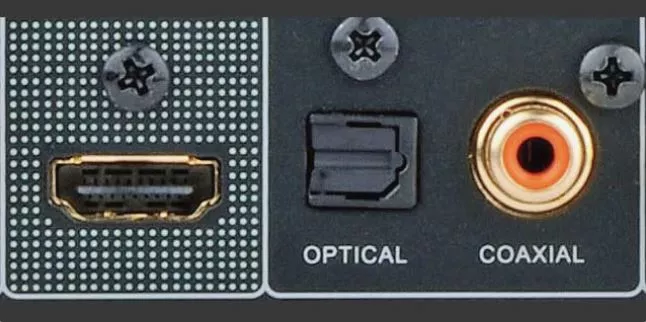
After you determine the audio settings you want to use to transfer audio from your Blu-ray player to the rest of your home theater system, you must also decide what type of connections to use. So after you can determine which audio settings you want to use to transfer audio from your Blu-ray Disc player to the rest of your home theater system, you must also decide what type of connections you need to use.
If you use either the coaxial or optical digital connection option of your Blu-ray player to your home theater receiver (very useful if your AV receiver does not have HDMI connections), you can also select the PCM vs Bitstream output options for those connections.
However, in this case, while the Bitstream output option can send a Dolby Digital or DTS 5.1 surround sound signal to your receiver for later decoding, the PCM option will only send a 2-channel signal.
The reason for this is that the optical digital cable or coaxial cable does not have sufficient bandwidth capacity to transfer a decoded, uncompressed, full surround sound signal, as the HDMI connection can.
If you are using the optical digital or coaxial digital connection option from your Blu-ray Disc player to your home theater receiver (useful if your home theater receiver does not have HDMI connections), you can also select PCM vs Bitstream output options for those connections.
However, in this case, whereas the Bitstream output option can send a standard Dolby Digital or DTS 5.1 surround sound signal to your receiver for later decoding, the PCM option will only send a two-channel signal. The reason for this is that a digital optical or coaxial digital cable does not have sufficient bandwidth capacity to transfer a decoded, uncompressed, fully surround audio signal as an HDMI connection can.
It should also be noted that optical/coaxial digital cables cannot transfer Dolby Digital Plus, Dolby TrueHD or DTS-HD Master Audio as a bitstream or PCM – HDMI is required.
Although the above discussion focuses on PCM vs Bitstream with respect to Blu-ray Disc players, the same information may also apply to Ultra HD Blu-ray Disc players.
Similarities Between Bitstream And PCM
While Bitstream and PCM are very different, these two configurations are very similar when applied in audio production. Here are several similarities to consider when choosing which is the best option for you:
- Both have great sound quality
- You can play both Bitstream and PCM files on most DVD and Blu-Ray players.
- Both signals must be converted into analog form to be heard through the speakers.
PCM and Bitstream: Main Differences
- PCM (pulse code modulation) is the “raw” signal generated by the AD converter. This means that the signal is not additionally source-coded by, for example, DTS or Dolby Digital, and is therefore not converted.
- As PCM, your signal is pure and usually in the highest quality. It takes up a lot of space but sounds very good.
- There are also formats such as Dolby Digital or DTS where the signal is (source-)encoded. In these two examples, the encoding is done with a loss of quality.
- However, there are also lossless compression methods such as DTS-HD Master Audio or Dolby TrueHD.
- These formats are transmitted in so-called bitstreams. Here you can choose whether, for example, your Bluray player or your AV receiver should do the decoding work. Note: If your receiver takes over the decoding, the corresponding logo usually appears on the display.
- The advantage of this is that the audio track can be compressed and stored on your Bluray, but you still get the highest quality in the end. Because the pure PCM signal can be recovered from the DTS-HD Master Audio track.
- The disadvantage of this is that your receiver must also support this decoding procedure. In this case, you can simply let your player decode the signal and output it as PCM and not as bitstream.
- This also means that your receiver does not necessarily have to support the new HD formats to play you back in full quality.
Final Verdict: PCM Or Bitstream
While audio signals are produced differently in both cases, there is no audible difference between Bitstream and PCM files. However, the Bitstream files are encoded to give you a surround sound experience when used with a compatible media player.
On the other hand, most audio players only support the PCM format while transmitting sound. That means you should check the compatibility of your device when choosing between the two.
HDMI is easily the best option for output. However, if you use either digital or optical coaxial outputs, Bitstream is the clear winner. Digital optical and coaxial connections suffer from limited bandwidth and can’t transfer a fully-processed and decoded signal. Because bitstream relies on the receiver for decoding, it’s ideal for limited bandwidth situations.
There are a number of factors that should go into your choice, including the quality of your Blu-ray player and audio receiver. More often than not, you will want Bitstream. The potential for greater audio quality and the flexibility to use coaxial outputs puts it ahead of PCM.
The only situation where PCM comes out on top is when using secondary audio streams. If you do not plan on doing this, and your receiver is not severely lacking in quality, go for Bitstream.
However, there is another factor to consider as to which setting may be best for you to decide in this discussion PCM vs Bitstream.
This involves access to secondary soundtracks, such as audio commentary, descriptive audio, or other supplementary audio tracks.
If access to these audio features is important to you then keep your Blu-ray player configured with the PCM audio output option that would be the best choice for you.
Alternatively, you can always switch from PCM to Bitstream at any time by going to the appropriate settings menu.
What is PCM: Pulse Code Modulation
PCM is an algorithm for representing an analog wave digitally and has been around since the beginning of the 1900s. This is not the only algorithm out there, there’s pulse width modulation, pulse position, pulse density, delta-sigma (which is used with DSD), and others but PCM is by far the standard (for audio). PCM itself comes in a couple of flavors, regular PCM where quantization levels is a function of amplitude and LPCM where quantization levels are uniformly linear (hence linear pulse code modulation).
Since PCM is an algorithm, compressed/noncompressed doesn’t make any sense from a technical standpoint, it takes an input and gives you an output and doesn’t care what the data is.
Because this is the standard (for audio), pretty much everything uses it AVR, pre/pro, stereo receiver, sound cards/onboard sound, pretty much everything that deals with converting digital to audio (and audio to digital) uses PCM at the bottom of the chain.
But like a lot of things, it takes on new meanings though it is not necessarily correct in the strictest sense, in this instance many people also include the digital output as just “PCM” also.
Well, it is just a data file you can call it PCM data file but when it is just referred to as PCM misunderstandings happen (and the thing you have to understand is that going from analog to digital is not 1 to 1, going from digital to analog is though so in a broad general sense PCM is a lossy compression algorithm itself). That data file is not very useful unless you know the parameters used by the PCM encoding so we use headers and containers for streaming/storage.
Wav, AIFF, FLAC, Ogg, mp3, DD, DTS, etc are all containers, some happen to be more than just that such as FLAC, MPEG, DD, DTS (and others) which are also a compression algorithm(some lossy, some lossless) and/or encoding scheme. When you play any of these formats, they all are converted to PCM data for the DAC to use. Yes, I know, you see chips that include DD/DTS decoding and they do that, but it is still a conversion to PCM data first before converting to analog.
Pulse Code Modulation, the coded data stream that occurs when analog audio information is converted into digital signals. In the PCM data stream of the CD, the sampling rate is 44.1 kHz, i.e. during one second, the analog signal is sampled 44,100 times and converted into a digital value. For Dolby Digital the sampling frequency is 48 kHz, for DVD-Audio 96 kHz. The quantization (also called resolution) indicates how many different digital values a signal can be converted into. 16-bit word width is standard for the CD. This allows 65,556 different audio information to be represented.
In the DVD-Audio standard, the resolution is 24 bit. This allows 16.77 million different pieces of information to be displayed, which is 256 times the fine resolution of the standard CD.
What Is LPCM: Linear Pulse Code Modulation
Linear Pulse Code Modulation = the uncompressed, linear PCM sound contained on the DVD. LPCM can be stored in different quantization or resolutions (16 bit, 20 bit or 24 bit) and in different sampling rates or sampling frequencies (48 kHz or 96 kHz).
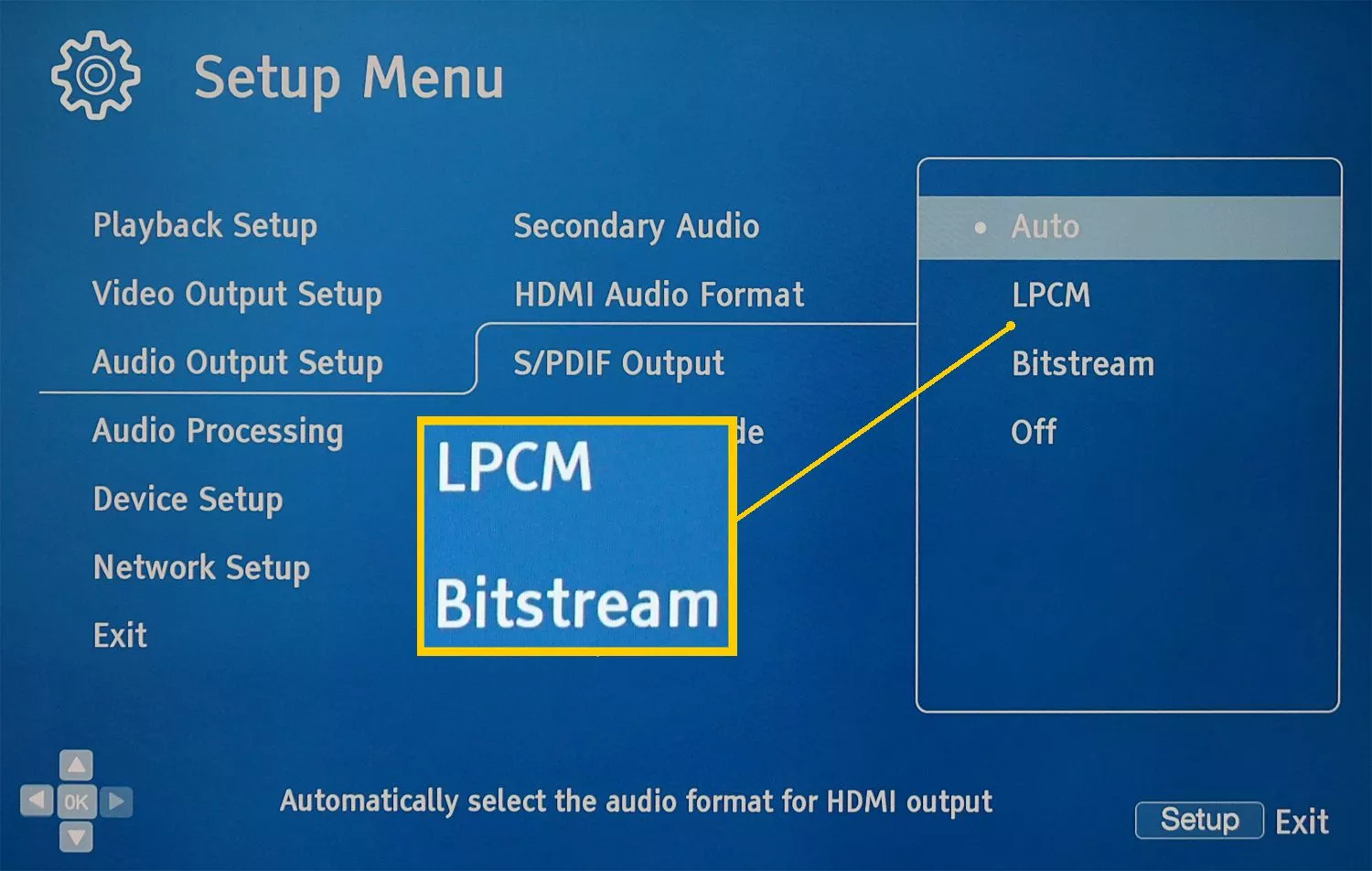
What Is Bitstream
A sequence of digital data consisting of a string of bits. For example, a satellite transponder transmits its digital TV programs as a bitstream. The receiving system on earth converts the bitstream into viewable TV programs. A DVD player outputs a bitstream at its audio-digital output.
PCM And LPCM Differences
Normal PCM, as in the audio CD sector, transmits up to two channels. LPCM can transmit up to eight channels.
Please do not lump PCM and LPCM together, even though they are both the same technology. MP2 is also not the same as MP3 even if they are the “same technology”.  There are several recording modes with different resolutions (8, 12, 16, 20, and 24 bit) and different sampling rates (32kHz, 44.1kHz, 48kHz, 88.2kHz, and 96kHz) for LPCM.
There are several recording modes with different resolutions (8, 12, 16, 20, and 24 bit) and different sampling rates (32kHz, 44.1kHz, 48kHz, 88.2kHz, and 96kHz) for LPCM.
Playstation Specific Case For Bitstream And PCM
This is the question that all owners of a home cinema system with an AV receiver and console like PS4 are asking themselves: PCM vs Bitstream? What that actually is and which setting delivers the better sound is revealed here.
Let us imagine the following setup: The PlayStation 4 is connected to the AV receiver via HDMI cable, the AV receiver is also connected to the television via HDMI and a 5.1 box set is connected to the AV receiver.
In the sound settings of the PS4, the user can now choose between Linear PCM and DTS (Bitstream) and Dolby Digital (Bitstream). If PCM is selected, the PS4 takes over the audio decoding of the sound material and passes it to the AV receiver, which usually outputs it to the speakers unchanged with the specified number of channels. So if the PCM signal is stereo, the only stereo will be output. If the signal is a 5.1 signal, 5.1 sound will also come out.
If the PS4 is set to bitstream – regardless of the audio technology, for example, DTS or Dolby Digital – the PS4 passes the unprocessed signal to the AV receiver, which then takes over the audio decoding. Provided it also supports the sound codec set on the PS4.
PCM is therefore merely a specification that controls which device is used for decoding. The choice depends on the quality of the individual devices – in this case on whether AV receivers or PS4s are better at decoding. In general, however, the AV receiver is usually the better choice.
After all, it is designed for such cases. PCM is best suited to those who do not have an AV receiver and output the sound via the TV boxes. This also calls for PCM: If you want to output HD sound formats such as Dolby True HD or DTS HD, but the AV receiver does not support them.

I am Bob. I work as an audio engineer and audio technician. I work in mastering and arranging bridges in existing songs and the arrangement and orchestration of the chorus. In Planet HiFi I test gear for a couple of days and write a review. I also write about AV topics, amplifiers, speakers, and headphones.


Gary Schaut
Sunday 5th of February 2023
REMARKABLE!
This is the most well laid out, clear and detailed pieces of PCM v. Bitstream I have come across and I am not a young man.
Many thanks for your time, expertise and very thoughtfully presented article.
Dan
Wednesday 4th of January 2023
I have a LG B2 OLED, Onkyo atmos receiver, and Panasonic UHD player. When I set bitstream on the player I get lip sync/sound delay, but when I select PCM it’s fine, but then it’s not using my HDMI Audio out… how do I Fix it to where I don’t have sync issues and still output my audio to my receiver(hdmi video going directly to TV 4k120hz, hdmi audio going to BLURay/dvd on receiver)
Ian
Thursday 20th of August 2020
Great article.